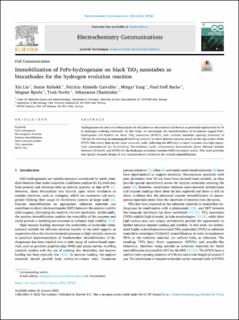| dc.contributor.author | Liu, Xin | |
| dc.contributor.author | Risbakk, Sanne | |
| dc.contributor.author | Almeida Carvalho, Patricia | |
| dc.contributor.author | Yang, Mingyi | |
| dc.contributor.author | Backe, Paul Hoff | |
| dc.contributor.author | Bjørås, Magnar | |
| dc.contributor.author | Norby, Truls | |
| dc.contributor.author | Chatzitakis, Athanasios | |
| dc.date.accessioned | 2022-06-17T06:55:38Z | |
| dc.date.available | 2022-06-17T06:55:38Z | |
| dc.date.created | 2022-01-29T14:43:29Z | |
| dc.date.issued | 2022 | |
| dc.identifier.citation | Electrochemistry communications. 2022, 135, 1-5 . | en_US |
| dc.identifier.issn | 1388-2481 | |
| dc.identifier.uri | https://hdl.handle.net/11250/2999164 | |
| dc.description.abstract | Hydrogenases are attractive biocatalysts for utilization in electrochemical devices as potential replacement for Pt in hydrogen evolving electrodes. In this work, we investigate the immobilization of ferredoxin tagged FeFe-hydrogenase (Fd-HydA1) on black TiO2 nanotubes (bTNTs), with uniform nanotube opening diameters of 140 nm. By utilizing an immunogold labelling method, we show that the enzymes attach on the top surface of the bTNTs film rather than on the inner nanotube walls, reflecting the difficulty to insert enzymes into high aspect-ratio nanomaterials for O2-shielding. Nevertheless, cyclic voltammetry demonstrates direct electron transfer between Fd-HydA1 and bTNTs for the hydrogen evolution reaction (HER) in neutral media. This work provides new insight towards design of new nanostructured electrodes for enzyme immobilization. | en_US |
| dc.language.iso | eng | en_US |
| dc.publisher | Elsevier | en_US |
| dc.rights | Navngivelse 4.0 Internasjonal | * |
| dc.rights.uri | http://creativecommons.org/licenses/by/4.0/deed.no | * |
| dc.subject | Black TiO2 | en_US |
| dc.subject | TiO2 nanotubes | en_US |
| dc.subject | Direct electron transfer | en_US |
| dc.subject | Enzyme immobilization | en_US |
| dc.subject | Bio-inorganic electrode | en_US |
| dc.subject | FeFe-hydrogenase | en_US |
| dc.title | Immobilization of FeFe-hydrogenase on black TiO2 nanotubes as biocathodes for the hydrogen evolution reaction | en_US |
| dc.title.alternative | Immobilization of FeFe-hydrogenase on black TiO2 nanotubes as biocathodes for the hydrogen evolution reaction | en_US |
| dc.type | Peer reviewed | en_US |
| dc.type | Journal article | en_US |
| dc.description.version | publishedVersion | en_US |
| dc.rights.holder | © 2022 The Authors. Published by Elsevier B.V. | en_US |
| dc.source.pagenumber | 5 | en_US |
| dc.source.volume | 135 | en_US |
| dc.source.journal | Electrochemistry communications | en_US |
| dc.identifier.doi | 10.1016/j.elecom.2022.107221 | |
| dc.identifier.cristin | 1993149 | |
| dc.relation.project | Norges forskningsråd: 275058 | en_US |
| dc.relation.project | Norges forskningsråd: 288320 | en_US |
| dc.source.articlenumber | 107221 | en_US |
| cristin.ispublished | true | |
| cristin.fulltext | original | |
| cristin.qualitycode | 1 | |

